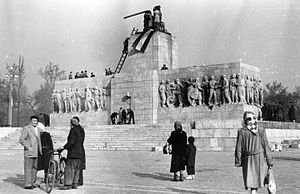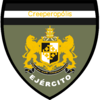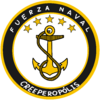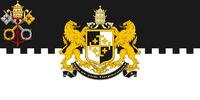Salvadoran Revolution of 1956: Difference between revisions
No edit summary |
|||
| Line 57: | Line 57: | ||
=== Further Repressions === | === Further Repressions === | ||
El Salvador became a Romerist state under the authoritarian leadership of [[Alfredo Figueroa Salinas]] under the oversight of [[Romero II of Creeperopolis|Romero II]]. Under Figueroa's regime, the [[ | El Salvador became a Romerist state under the authoritarian leadership of [[Alfredo Figueroa Salinas]] under the oversight of [[Romero II of Creeperopolis|Romero II]]. Under Figueroa's regime, the [[National Intelligence Directorate]] (DINA) began a series of purges, first within the government to end opposition to Figueroa's regime. The victims were labeled as "Miguelists", "communist agents", or "Manuelists" for as insignificant a crime as spending time in Granadian controlled territory in the [[Salvadoran War]]. In total, at least 7,000 people were arrested or killed. | ||
From 1950 to 1952, POSEC forcibly relocated thousands of people to obtain property and housing for Initiative members and to remove the threat of the intellectual and 'bourgeois' class. Thousands were arrested, tortured, tried, and imprisoned in concentration camps, deported to the north, or were executed. In a single year, more than 26,000 people were forcibly relocated from [[Ciudad Los'Ángeles]]. As a consequence, jobs and housing were very difficult to obtain. The deportees generally experienced terrible living conditions and were interned as slave labor on collective farms. Many died as a result of poor living conditions and malnutrition. All these actions were justified by the Creeperian and Salvadoran governments as "anti-communist actions." | From 1950 to 1952, POSEC forcibly relocated thousands of people to obtain property and housing for Initiative members and to remove the threat of the intellectual and 'bourgeois' class. Thousands were arrested, tortured, tried, and imprisoned in concentration camps, deported to the north, or were executed. In a single year, more than 26,000 people were forcibly relocated from [[Ciudad Los'Ángeles]]. As a consequence, jobs and housing were very difficult to obtain. The deportees generally experienced terrible living conditions and were interned as slave labor on collective farms. Many died as a result of poor living conditions and malnutrition. All these actions were justified by the Creeperian and Salvadoran governments as "anti-communist actions." | ||
Revision as of 06:40, 20 December 2019
| Salvadoran Revolution of 1956 | |||||||
|---|---|---|---|---|---|---|---|
| Part of the Reign of Romero II | |||||||
 The Salvadoran Flag with the coat of arms cut out, a symbol of the revolution. | |||||||
| |||||||
| Belligerents | |||||||
|
|
File:Flag of the Principality of El Salvador.png El Salvador | ||||||
| Commanders and leaders | |||||||
| Strength | |||||||
| Unknown | 50,000 soldiers | ||||||
| Casualties and losses | |||||||
|
1,000-3,000 dead 4,000-5,000 injured |
389 dead 681 injured | ||||||
|
1,389-3,500 total dead 4,681-6,000 total injured Thousands arrested | |||||||
The Salvadoran Revolution of 1956 (Creeperian Spanish: Revolución Salvadoreño de 1956) or the Salvadoran Uprising, was a nationwide revolution against the Principality of El Salvador and its Creeperian-imposed policies, lasting from June 23, 1956 until November 11, 1956. It was the first major threat to Creeperopolis since the Romerists defeated the Miguelists in the Creeperian Civil War (1933-1949).
The revolt began as a student protest against the authoritarian Creeperian government which attracted thousands as they marched through central Ciudad Los’Ángeles to the Salvadoran capitol building, calling out on the streets using a van with loudspeakers. A student delegation, entering the radio station to try to broadcast the students' demands, was detained. When the delegation's release was demanded by the protesters outside, they were fired upon from within the building by the Creeperian secret police, known as DINA (acronym for Dirección De Inteligencia Nacional, literally "National Intelligence Directorate"). One student died and was wrapped in a flag and held above the crowd. This was the start of the revolution. As the news spread, disorder and violence erupted throughout the capital.
The revolt spread quickly across El Salvador and the government collapsed. Thousands organised into militias, battling DINA and Creeperian troops. Pro-Creeperian Romerists and DINA members were often executed or imprisoned and former political prisoners were released and armed. Radical impromptu councils wrested municipal control from the ruling Creeperian Initiative and demanded political changes. A new government declared that DINA was disbanded and pledged to re-establish free elections. By the beginning of November, fighting had almost stopped, and a sense of normality began to return.
On November 4, 1956, a large Creeperian force invaded Ciudad Los’Ángeles and other regions of the country. The Salvadoran resistance continued until November 11. Around 3,000 Salvadorans and 400 Creeperian troops were killed in the conflict. Mass arrests and denunciations continued for months thereafter. By January 1957, the new Creeperian-installed government had suppressed all public opposition. DINA was withdraw from El Salvador in 1956, however, to appease the Salvadorans.
Public discussion about the revolution was suppressed in El Salvador for more the duration of the reign of Romero II. After his reign, his sons Adolfo V and Romero III initiated reforms and reconciled with the Salvadorans, allowing political freedoms. Under Alexander II, support for the revolution remains illegal. Following the declaration of martial law in 2019, DINA activities resumed in El Salvador.
Prelude
During the Salvadoran War (and the Creeperian Civil War and Papal War), El Salvador was a member of the Romerists, allied with the forces of the Catholic Imperial Restoration Council (CRIC), the State of the Church, the Kingdom of Atlántida, and the Kingdom of Castilliano. In 1935, the Romerist Salvadoran military defeated the Miguelist-backed State of Granada, ending the Salvadoran War. The Salvadoran and Creeperian Armies were able to defeat the Miguelists in 1949 after the fall of San Salvador.
Post-War Military Presence
From 1935 onwards, the Creeperian Armed Forces de facto occupied El Salvador, as opposed to the prior client state relationship with Creeperopolis. Immediately after the civil war, the military established a puppet government in El Salvador ruled by the Creeperian Initiative, an authoritarian Catholic Creeperian Romerist political party, with Romero II as ceremonial Emperor and Alfredo Figueroa Salinas as Regent Grand Prince (as Romero II is yet to have children).
Figueroa banned opposing political parties in El Salvador, such as the Salvadoran Peoples' Party (PPS) and the Salvadoran Nationalist Party (PNS), to ensure the Creeperian Initiative controls the entire government.
The banning of Salvadoran political parties created tensions between the pro-Creeperian government and the Salvadoran people.
Further Repressions
El Salvador became a Romerist state under the authoritarian leadership of Alfredo Figueroa Salinas under the oversight of Romero II. Under Figueroa's regime, the National Intelligence Directorate (DINA) began a series of purges, first within the government to end opposition to Figueroa's regime. The victims were labeled as "Miguelists", "communist agents", or "Manuelists" for as insignificant a crime as spending time in Granadian controlled territory in the Salvadoran War. In total, at least 7,000 people were arrested or killed.
From 1950 to 1952, POSEC forcibly relocated thousands of people to obtain property and housing for Initiative members and to remove the threat of the intellectual and 'bourgeois' class. Thousands were arrested, tortured, tried, and imprisoned in concentration camps, deported to the north, or were executed. In a single year, more than 26,000 people were forcibly relocated from Ciudad Los'Ángeles. As a consequence, jobs and housing were very difficult to obtain. The deportees generally experienced terrible living conditions and were interned as slave labor on collective farms. Many died as a result of poor living conditions and malnutrition. All these actions were justified by the Creeperian and Salvadoran governments as "anti-communist actions."
Students Arrested
In June 1956, students, writers, and journalists began to protest the living conditions created by Figueroa's regime in the streets of Ciudad Los'Ángeles. Students and journalists started a series of intellectual forums examining the problems facing El Salvador. These forums became very popular and attracted thousands of participants.
On June 22, 1956, students of the University of Ciudad Los'Ángeles compiled a list of thirty-three points containing several national policy demands. The students decided to organize a parallel demonstration of sympathy and unity on June 23, 1956.
Revolution
First Shots
On the afternoon of June 23, 1956, approximately 20,400 protesters convened next to the statue of Romero I, the Creeperian Emperor during the civil war. Paúl Sáenz Mina, President of the University of Ciudad Los'Ángeles, read a manifesto to the crowd, which included: The desire for El Salvador to be independent from all foreign powers (Creeperopolis); a political system based on a representative democracy; and citizens of El Salvador should have all the rights of free men. After the students read their proclamation, the crowd chanted a censored patriotic poem the "National Song", with the refrain: "This we swear, this we swear, that we will no longer be slaves." Someone in the crowd cut out the Salvadoran coat of arms from the Salvadoran flag, leaving a distinctive hole, and others quickly followed suit. Afterwards, most of the crowd moved to outside the capitol building. By 6pm, the multitude had swollen to more than 200,000 people; the demonstration was spirited, but peaceful.
At 8pm, Figueroa broadcasted a speech condemning the writers' and students' demands. Angered by Figueroa's hard-line rejection, some demonstrators decided to carry out one of their demands, the removal of Romero I's 40-foot-high bronze statue that was erected in 1951. By 9:30pm, the statue was toppled and crowds celebrated by placing Salvadoran flags on Romero I's boots, which was all that was left of the statue.
At about the same time, a large crowd gathered at the radio station in the city, which was heavily guarded by POSEC. The flash point was reached as a delegation attempting to broadcast their demands was detained and the crowd grew increasingly unruly as rumours spread that the protesters had been shot. Tear gas was thrown from the upper windows and POSEC opened fire on the crowd, killing many. POSEC tried to re-supply itself by hiding arms inside an ambulance, but the crowd detected the ruse and intercepted it. Salvadoran soldiers sent to relieve POSEC under the command of Tomás Alemán Prats hesitated and then, tearing the Cross of Creeperopolis from their caps, sided with the crowd. Provoked by the POSEC attack, protesters reacted violently. Police cars were set ablaze, guns were seized from military depots, and distributed to the masses and symbols of the Romerist regime were vandalized.
Fall of the Government
During the night of June 23, Alfredo Figueroa Salinas requested a Creeperian military intervention "to suppress a demonstration that was reaching an ever greater and unprecedented scale". The Creeperian leadership ignored his demands, believing the situation wasn't serious, and even if it was, the Salvadoran army would take care of it.
Armed protesters attempted to seize the radio building but were were fired upon by POSEC guards who were then driven out as armed demonstrators arrived. At this point, the revolutionaries' wrath focused on POSEC.
On June 30, a mass of protesters gathered in front of the capitol building. POSEC units began shooting into the crowd from the rooftops of neighboring buildings. Some Salvadoran soldiers returned fire on POSEC. Supplied by arms taken from POSEC or given by Salvadoran soldiers who joined the uprising, some in the crowd started shooting back.

The attacks at the capitol forced the collapse of the government. Alfredo Figueroa Salinas was captured by the revolutionaries on July 12 and publicly executed on July 13. Revolutionaries began an aggressive offensive against the remnants of POSEC isolated in El Salvador. Paúl Sáenz Mina declared the establishment of the Salvadoran Republic on July 13, 1956, with himself as Acting President.
On July 29, Tomás Alemán Prats' forces attacked the capitol building, killing many inside. Units led by Prats, after attacking the capitol building, later executed dozens of suspected Romerists, Creeperian sympathizers, and POSEC members. Photographs showed victims with signs of torture.
It was not until August 29, 1956, that the severity of the situation had reached San Salvador and Romero II was alerted to the situation.
By September 1, most of central El Salvador had come under revolutionary control with the north and east remaining loyal to Creeperopolis.
Creeperian Response
On September 15, Sáenz received reports that Creeperian forces were planning an invasion of El Salvador. As a result, the Salvadoran Army was mobilized for total war with Creeperopolis.
Romero II with the support of Chief Field Marshal Alfonso Cabañeras Moreno and Field Marshal Orlando López Jiménez planned the invasion of El Salvador for September 30.
The Creeperian invasion was launched ahead of schedule on September 29 to attempt to catch the Salvadorans off guard should the plans have been leaked. The Salvadoran Army was prepared however, and fighting began on the border.
Creeperian troops arrived to Ciudad Los'Ángeles on October 14, 1956, after heavy resistance from Salvadoran soldiers.

From October 15-October 31, the city was constantly shelled to lower morale and the Salvadorans' will to fight.
On November 10, 1956, Sáenz and his government surrendered to the Creeperian Army. The remaining revolutionaries surrendered the following day, ending the Salvadoran Republic and the Revolution.
Aftermath
In the immediate aftermath, many thousands of Salvadorans were arrested. Eventually, 26,000 of these were brought before the Creeperian courts, 22,000 were sentenced and imprisoned and 4,000 executed.
With El Salvador under Creeperian control by November 12, Alfonso Cabañeras Moreno became the Regent Grand Prince. Only one reform was made under Romero II and Cabañeras: the agreement to withdraw POSEC from El Salvador. (This reform would later be overturned by Alexander II during the 2019 martial law declaration.
Paúl Sáenz Mina and Tomás Alemán Prats were executed for treason in February 1957 in San Salvador.
Creeperian censorship kept the revolution from the Creeperian population. It was only during the reign of Romero III was the revolution publicized and reforms truly began.
Sympathy for the revolution remains illegal.






